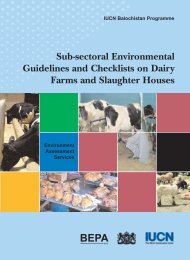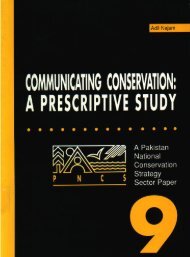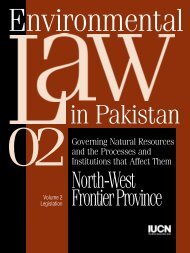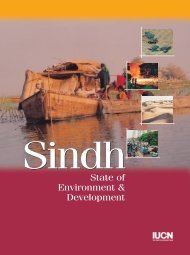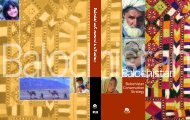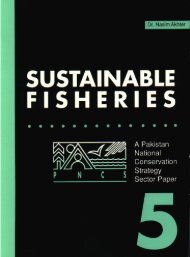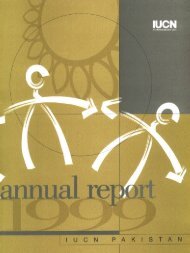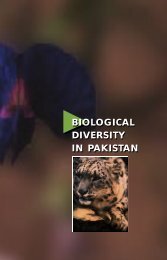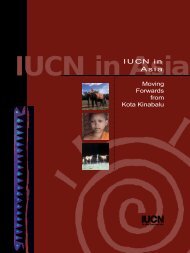Nigel JR Allan - IUCN - Pakistan
Nigel JR Allan - IUCN - Pakistan
Nigel JR Allan - IUCN - Pakistan
Create successful ePaper yourself
Turn your PDF publications into a flip-book with our unique Google optimized e-Paper software.
6<br />
the knowledge of community appointed men who adjudicate disputes<br />
about land, water, pastures, and territory. With the emigration of many<br />
young men to the urban areas women’s roles have changed as they have<br />
had to assume male jobs in the subsistent household in addition to their<br />
extensive domestic duties. The problems created by male emigration are<br />
only now being explored and are not yet well documented.<br />
By the end of the nineteenth century photographic developing and<br />
printing was being accomplished in the field. European visitors were surveying<br />
and photographing the high peaks and glaciers of the Karakorum<br />
in order to authenticate their travel and climbing achievements. Some of<br />
these early photographs, for example those by Sella, are excellent. Most of<br />
the books published today on the Karakorum are greatly embellished by<br />
high quality photographs taken during climbing expeditions. Sometimes<br />
disputes about nomenclature were the subject of heated disputes in Victorian<br />
Britain where the Royal Geographical Society did not allow Britishers<br />
to have their names given to topographic features. Hence problems in nomenclature<br />
remain as can be seen in the dispute about the triglossal “K2”,<br />
a surveyor’s designation, but which also bears the name of Godwin Austin,<br />
an early surveyor, and Chogori, a local name given by travelers through<br />
the Mustagh Pass. For nomenclature in English in this sourcebook, there is<br />
no need for me to disagree with the toponymic conventions of Marc Aurel<br />
Stein, a foremost early European scribe of this region: Karakorum not<br />
Karakoram, Hindukush not Hindu Kush, and Himalaya not Himalayas.<br />
Geographers see the world through a different prism than others, hence<br />
my inclusion of all segments of the Karakorum mountains and adjacent<br />
regions in this sourcebook. The fact that the region is divided today among<br />
three different nation-states in the twentieth century is no reason to ignore<br />
the inherent historical geography found here. The Greater Himalaya mountains<br />
were known for their role in acting as conduits for the trade between<br />
South, and Central and Inner Asia. To give just one example of how little<br />
they acted as a barrier to commerce, gur (raw sugar) was transported from<br />
India in the nineteenth century across the mountains to Khotan where it<br />
was processed into confectionery and then carried back across the mountains<br />
to India where it was sold at a profit. Many of the historical sources<br />
cited in the sourcebook portray life as it was in the Karakorum while much<br />
of life today bears little connection with the past. For a foray into the intellectual<br />
history of Europeans in the Karakorum Himalaya the reader must<br />
consult the excellent essay by Hewitt (1989) on that topic.<br />
As a schoolboy my mind was fixed on those bombastic Scots who bullied<br />
and bashed their way into the mountains in these parts. Some had<br />
genuine contributions to make like Mountstuart Elphinstone and George<br />
Scott Robertson on the Hindukush people and culture and Forsyth’s expedition<br />
across the Karakorum to Yarkand. Who can forget “Bokhara” Burnes




